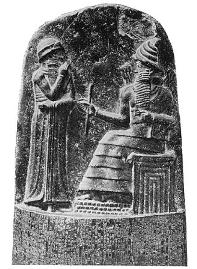How Did Legal Codes Provided Continuity in the Societies of Mesopotamia
Ancient Mesopotamia
Code of Hammurabi
History >> Ancient MesopotamiaThe first great king of Babylon was King Hammurabi. He conquered all of Mesopotamia and established the first Babylonian Empire. Hammurabi also established a set of laws that is today called the Code of Hammurabi.
How do we know about the Code of Hammurabi?
The Code of Hammurabi was written down on clay tablets and etched into stone. It is one of the oldest recorded codes of laws in the world. One of the best surviving examples of the code is written on the "diorite stele".

The top of the diorite stele by Unknown
Diorite Stele
The diorite stele is a large stone shaped like a giant finger. It is about seven feet tall and two feet wide. It contains around 4000 lines of text describing 282 different laws. At the top, or "fingertip", of the stele is a carved picture of King Hammurabi being given the laws from the Babylonian sun god Shamash.
The Code of Law
The actual code of law was divided up into groupings. Many of the laws that had to do with one subject (i.e. slavery) were grouped together. This would have helped people to find and read just the laws that pertained to them. Here are some of the major sections of the code:
- Prologue
- Legal Procedures
- Household laws
- Slavery
- Trade and business
- Religion
- Epilogue
Here is an excerpt from the prologue:
"bring about the rule of righteousness in the land, to destroy the wicked and the evil-doers; so that the strong should not harm the weak, so that I should rule …. and enlighten the land, to further the well-being of mankind".
In the epilogue Hammurabi restates his desire for justice for all saying "Let the oppressed man come and stand before my image as king of righteousness. Let him understand my words and his case, so he will understand what is just and his heart will be glad."
Examples of the Laws
Many of the laws describe exactly what a worker should earn. For example, one law states that a sailor should be paid six gur of grain per year.
Some laws were very harsh and the penalties severe:
- If a son should strike his father, his hands shall be cut off.
- If a man put out the eye of another man, his eye shall be put out.
- If any man should strike a man of higher rank, he shall receive sixty blows with an ox-whip.
- If a builder builds a house for someone and that house collapses killing them, then the builder shall be put to death.
The code itself tells archeologists a lot about the lives of the people of Babylon. It also contains some important ideas like having people provide evidence of a crime, innocent until proven guilty, and protection for the weak.
Interesting Facts about the Code of Hammurabi
- Shamash, who is featured at the top of the diorite stele, was the Babylonian god of law, justice, and salvation.
- The diorite stele is called "diorite" because it is made from a type of black rock called diorite.
- The diorite stele was originally found by archeologists in the ancient city of Susa. Today it can be found in the Louvre Museum in Paris, France.
- The Code of Hammurabi is one of the oldest and longest deciphered writings in existence.
- The code was written using cuneiform script and the Akkadian language.
- Take a ten question quiz about this page.
- Listen to a recorded reading of this page:
Learn More about Ancient Mesopotamia:
Works Cited
History >> Ancient Mesopotamia
Source: https://www.ducksters.com/history/mesopotamia/code_of_hammurabi.php
0 Response to "How Did Legal Codes Provided Continuity in the Societies of Mesopotamia"
Post a Comment